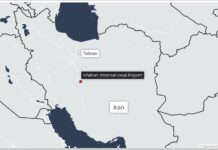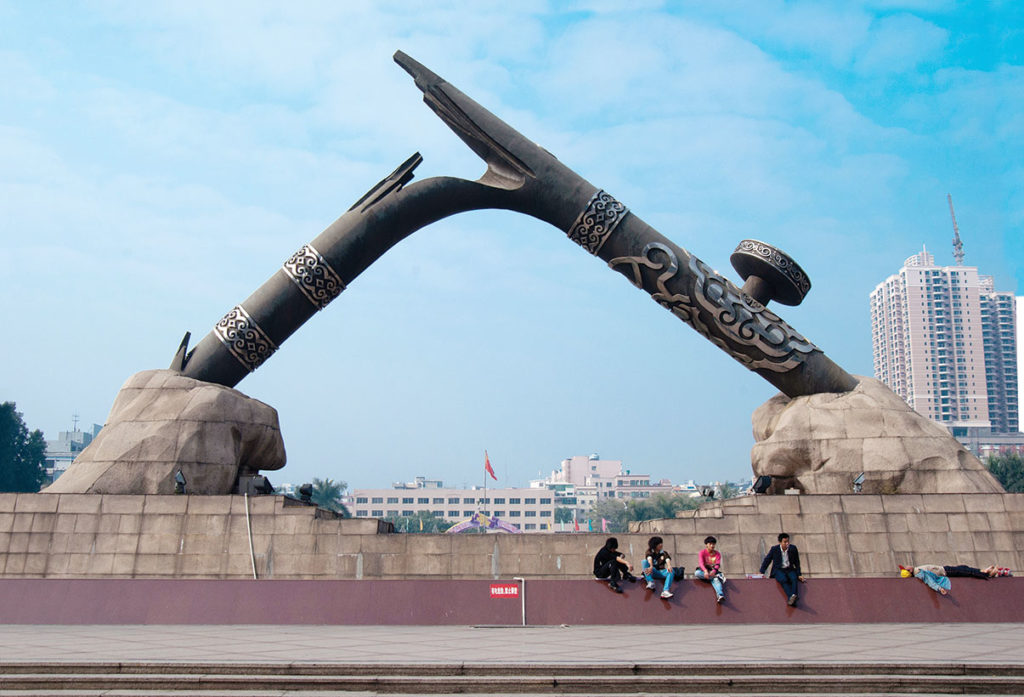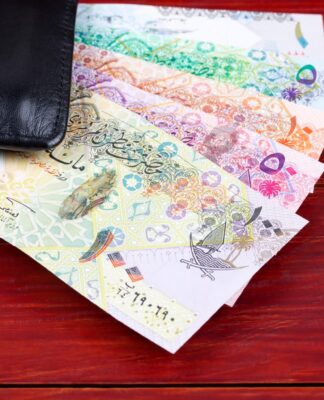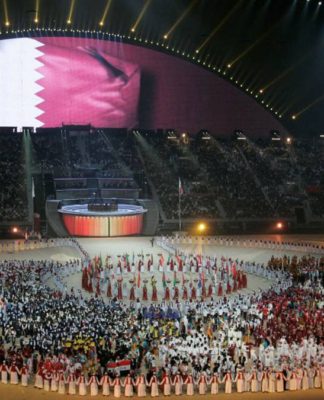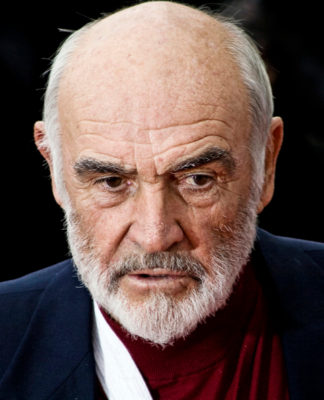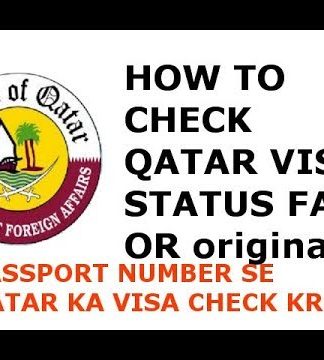China’s War on Drugs

The HEIC-owned Nemesis (at far right), under the command of Capt. William Hall and accompanied by several smaller British vessels, attacks Chinese junks in Anson’s Bay on Jan. 7, 1841.
National Maritime Museum
China warred with the British empire over the latter’s lucrative opium trade, leaving a bitter legacy
The 17th and 18th centuries saw an increased demand in Britain for Chinese commodities—particularly silk, porcelain and tea. China, by contrast, had little interest in British goods, rejecting the comparatively rough woolen and cotton textiles London sought in vain to export. The resulting trade imbalance left the British with little choice but to pay for their tea using silver, specifically Spanish silver, the only form of payment the Chinese truly trusted. Thus fortunes in silver flowed out of Britain. When the Spanish sided with the Americans in their Revolutionary War, however, that important currency dried up.
The Honourable East India Company (HEIC), a semi-private enterprise ruling much of the Indian subcontinent on the British government’s behalf, sensed an opportunity to alleviate the imbalance.
The solution lay in an ever-increasing demand in China for opium. The HEIC controlled opium grown in India, and it began exporting the narcotic to China. But the imperial court at Peking, concerned about the resulting outflow of silver, not to mention the negative impact opium was having on Chinese society, ultimately banned its import, save for small quantities for medicinal purposes.
That refusal sparked a series of military conflicts that would subject Qing dynasty China to the overwhelming and devastating firepower of the British army and Royal Navy, kill and injure tens of thousands of Chinese, and doom hundreds of thousands of others to lives of wretched addiction.
The Qing government’s rebuff of opium imports did not stop the HEIC’s quest for profit. To sidestep the ban, the company auctioned opium to third-party “country traders.” These merchants loaded the opium in India and sailed for China, where they illegally sold the drug to Chinese merchants. The HEIC reasoned that since the opium legally ceased to be their property following the auction, they could wash their hands of the matter should Chinese authorities intercept a trader’s ship. It was all a sham, as the country traders operated under HEIC licenses.

The titular head of British forces, Queen Victoria (depicted at left reviewing troops in an 1859 painting by George Housman Thomas) had no command authority during the Opium Wars. / Royal Collection Trust
The system worked because Chinese merchants and corrupt officials profited handsomely from the trade and simply ignored the ban. Imperial edicts were toothless, as authorities seldom enforced them, prompting ever more merchants to ignore them. Even the British treasury profited, collecting taxes from the opium auctions. In the early 1700s the number of opium chests (each containing 120–140 pounds of raw opium) exported to China each year numbered some 200. By the late 1760s it had risen to 1,000; in 1838 the total hit a staggering 40,000 chests.
For centuries the Chinese had used opium in small quantities, mostly for medicinal purposes, though also as a reputed aphrodisiac. Sometime after New World traders had introduced tobacco to China, smokers realized they could enhance their pleasure by adding opium syrup to their pipes. Over time they transitioned from tobacco to pure opium. Many people became hopelessly addicted.
The British, too, demanded the drug. Europeans of the era used opium as a painkiller and to treat bowel problems, usually taking it with alcohol as a tincture. Workers in northern England took an opium-based drug called “elevation” to boost energy, while babies were given Godfrey’s Cordial, also containing opium, to calm them. Recreational use of opium was also common. Among other prominent users was famed abolitionist William Wilberforce, who suffered unspecified gastrointestinal illnesses.
That said, some Britons strongly opposed the opium trade on moral grounds. The Rev. Algernon Thelwall, an evangelical clergyman, published a book on the subject in which he derided it as an “iniquitous trade” that “brought the greatest dishonour upon the British flag.” Yet the general population remained largely unaware of the controversial commodity, which proved increasingly lucrative. In 1835–36 alone the opium trade with China reaped an impressive $428 million in present-day dollars.
Despite recurring political clashes between Britain and China, the opium trade continued unabated well into the 19th century. In 1839, however, the Daoguang emperor—the seventh of the Qing dynasty—resolved to act. Rejecting calls for opium to be legalized and taxed, he dispatched Lin Zexu, a morally scrupulous Chinese viceroy, to Canton. All foreign trade with China had been restricted to that port city, where Western countries operated offices and warehouses known as “factories.”
Lin launched his war on opium by ordering the arrests of more than 1,700 Chinese involved in the trade, confiscating tens of thousands of opium pipes and appealing to Queen Victoria to abolish the trade. When all efforts proved fruitless, Lin resorted to force, directing Chinese troops to confiscate and destroy more than 20,000 chests of opium stored in British and other foreign warehouses and aboard British merchant ships. London responded with gunboat diplomacy, ordering a military expedition to China and unabashedly preparing to go to war over the right to sell a narcotic.

British troops advance against Chinese-held forts on Chuenpi and Taikoktow islands on Jan. 7, 1841, during the First Opium War. / Granger
That September British and Chinese vessels skirmished off Kowloon, but the initial major action of the First Opium War came two months later. Seeking to defuse tension over Lin’s actions, Sir Charles Elliot, the British plenipotentiary and chief superintendent of trade in China, ordered a blockade of all British shipping on the Pearl River. But on November 3 the merchant ship Royal Saxon signed a bond with Chinese authorities not to sell opium, ignored the blockade and approached Canton with a cargo of cotton. HMS Volage and HMS Hyacinth responded by firing warning shots.
Watching events from harbor was Chinese Adm. Guan Tianpei, who immediately sailed to Royal Saxon’s aid with a fleet of war junks. In the ensuing First Battle of Chuenpi the junks proved no match for the Royal Navy warships, which sank four of Guan’s vessels.
In January 1840 the Daoguang emperor ratcheted up tensions with a demand that other foreign merchants trading in China cease any cooperative efforts with the British. On receiving the news in London, hawkish Foreign Secretary Henry John Temple, 3rd Viscount Palmerston, sent instructions to George Eden, 1st Earl of Auckland and governor-general of India, to prepare naval and military forces for a punitive expedition to China.
The plan was to continue the Pearl River blockade and capture Chusan Island for use as a forward operating base. The Royal Navy would then blockade the Yangtze River and send warships to the Bohai Sea, inland of the Yellow Sea. By doing so, Lord Palmerston hoped to force the emperor to accept a list of demands, the most important being to open additional ports to British trade.
The British expedition—its naval element under Commodore Sir James Bremer and land forces under Maj. Gen. Hugh Gough—arrived in Chinese waters in June and sailed for Chusan. The local Chinese commander refused Elliot’s demand to surrender, so on July 5 the British took the island by force, occupying the capital of Tinghai the next morning. “The gate was found strongly barricaded within by large sacks of grain,” Brig. Gen. George Burrell recalled. “A company of the 49th [Regiment of Foot]…took possession of the principal gate of the city of Tinghae-heen [sic], upon which the British flag was hoisted.” Its initial objective achieved, the expeditionary force split, one fleet heading up the Pearl, the other to the Yellow Sea.
Forcing his way upriver toward Canton, Commodore Bremer found the forts in the strait of Humen (aka Bogue) heavily garrisoned and bristling with guns. On Jan. 7, 1841, his warships opened the Second Battle of Chuenpi, sinking seven junks while landing parties seized the forts. At that point the Chinese sought to negotiate, sending Lin Zexu’s successor, Qishan, to speak with Elliot. Within days the resulting Convention of Chuenpi reopened trade at Canton, ceded Hong Kong to Britain and compensated British merchants for their opium losses. In return the British agreed to evacuate Chusan. Not everyone was satisfied, however. Palmerston refused to ratify the treaty and dismissed Elliot for not having demanded enough from the Chinese, while the Daoguang emperor had Qishan arrested and very nearly executed for having ceded too much.
The unresolved tension led to the February 26 Battle of the Bogue, an amphibious assault on Chinese forts in the Humen, followed the next day by the Battle of the First Bar—both ending in British victory. Continuing up the Pearl, the British destroyed several forts and captured Whampoa on March 2. Between March 13 and 15 a naval force sent up the Broadway River destroyed many junks and captured several forts. Prominent among the British warships was Capt. William Hall’s HEIC-owned 46-gun iron steamship Nemesis, able to navigate shallow waters and wreak havoc on the Chinese shore defenses. On March 18 the British attacked Canton, liberating their factory before taking the high ground overlooking the city.

Many people in China became hopelessly addicted to opium. / Welcome Library
Trade at Canton resumed until the Chinese recaptured the factory on May 21. Four days later the British counterattacked, bombarding the city and forcing Chinese defenders to flee. Fighting ended with the capture of Canton on May 30. Elliot and Yishan (Qishan’s successor as viceroy) agreed to a new cease-fire, followed by the signing of another peace treaty and the withdrawal of British forces beyond the Bogue. The emperor remained dissatisfied and refused peace.
Meanwhile, Palmerston, replaced Elliot’ as plenipotentiary and trade superintendent with Sir Henry Pottinger, who arrived in Hong Kong on August 10. Another newcomer was British naval commander Adm. Sir William Parker, who with Gough resolved to continue operations against China, setting sail for Amoy on August 21. A number of actions in central China followed, including the Battle of Amoy on August 26, the recapture of Chusan on October 1, the Battle of Ningpo on March 10, 1842, and the Battle of Chapu on May 18. The British prevailed.
When the emperor still refused to relent, Gough struck up the Yangtze in hopes of advancing into interior China. British and Chinese forces clashed at the Battle of Woosung on June 16, leading to the British capture of Shanghai. On July 21, in the last major action of the war, the British stormed the city of Chinkiang. Amid bitter street fighting, on realizing defeat was imminent, many Chinese committed suicide. “Finding dead bodies of [Chinese] in every house we entered,” Gough recalled, “principally women and children, thrown into wells or otherwise murdered by their own people, I was glad to withdraw the troops from this frightful scene of destruction.”
The battle had also disrupted China’s Caoyun system, a vital grain transportation waterway, forcing the emperor to sue for peace.
The First Opium War ended on August 29 when Pottinger and imperial representatives met aboard HMS Cornwallis to sign the Treaty of Nanking. Effectively ending the restrictive Canton system, its terms opened the ports of Amoy, Foochow, Ningpo and Shanghai to foreign trade. It also ceded Hong Kong to Britain and awarded reparations to Britain for lost opium and war-related expenses. The agreement marked the first in a series of one-sided accords China later dubbed the “unequal treaties.”
Despite the gains Britain achieved through the Treaty of Nanking, London soon demanded further concessions, including extraterritorial rights for British subjects in China (exempting them from Chinese law) and most-favored-nation status (extending to Britain any future rights granted to other foreign powers). Under pressure the Chinese agreed, signing the supplementary Treaty of the Bogue in October 1843.
As years passed the British pushed for further concessions from China. Neither treaty had legalized the opium trade, a step the Chinese resisted, thus the original casus belli was unresolved. London also felt Peking was disrespecting British diplomats and dragging its feet over implementation of the treaty provisions. Lord Palmerston, appointed prime minister in 1855, arrogantly proclaimed the Chinese needed “a dressing [down] every eight to 10 years to keep them in order.” To declare war, however, he needed a pretext.
An opportunity presented itself in October 1856, when Chinese officials boarded the cargo ship Arrow at Canton and arrested its crew. Though Arrow had been registered as a British ship and helmed by a British captain, authorities believed members of its Chinese crew had been pirates. Furthermore, Arrow’s registration had expired, thus it was not under British legal protection. The Chinese boarding party duly lowered Arrow’s Union Jack. Sir Harry Parkes, British consul at Canton, demanded local viceroy Ye Mingchen release the crew and apologize for having lowered the flag. Ye released the crew, but when he refused to apologize over the flag incident, Parkes ordered British warships to bombard Canton. The Chinese retaliated by burning down the factories. “The English barbarians have attacked the provincial city and wounded and injured our soldiers and people,” a furious Ye proclaimed to the Cantonese. “I herewith distinctly command you to join together to exterminate them.”
Two key events delayed the British response. First, opposition in the House of Commons to a renewal of hostilities led to a parliamentary vote, forcing a general election in April 1857. British voters returned an even greater majority for Palmerston’s government. A month later the unrest in India that would flare into the Sepoy Mutiny grew worse, forcing London to divert China-bound troops to quell the rebellion. Meanwhile, Britain gained an unlikely ally. Concerned the British were dominating trade with China, France looked to join the war. Paris’ casus belli was the murder of French missionary Auguste Chapdelaine in Guangxi province for having dared to minister to a region closed to foreigners.
The British captured Canton on New Year’s Day 1858 and arrested Ye, exiling him to Calcutta. In May an Allied force under British Rear Adm. Michael Seymour took the strategically important Taku forts on the Peiho River. The subsequent capture of Tientsin led to the signing of yet another treaty, in June 1858. That accord provided for foreign diplomatic legations at Peking, the opening of 10 more ports and the free movement of foreigners across interior China. Although a break in the fighting followed, neither London nor Peking would ratify the treaty, leading to a resumption of hostilities.
As the Treaty of Tientsin had returned the Peiho River forts to the Chinese, the forts would have to be retaken. Unfortunately for the Allies, in late June 1859 they lost the Second Battle of the Taku Forts to Chinese forces under Mongol commander Sengge Rinchen. The loss proved humiliating back home in Britain and France. On September 12 a horrified Times of London thundered, “We shall teach such a lesson to those perfidious hordes that the name ‘European’ will hereafter be a passport of fear!”
On Aug. 21, 1860, an Allied force under British Lt. Gen. Sir James Hope Grant and French Lt. Gen. Charles Cousin-Montauban launched the Third Battle of the Taku Forts. This time the attackers were victorious. “The garrison was driven back step by step and hurled pell-mell through the embrasures on the opposite side,” Grant recalled of the moment French troops entered one of the forts. “The ground outside the fort was literally strewn with the enemy’s dead and wounded: Three of the Chinese were impaled on [their own] stakes.”
Avenged for their humiliation, the Allies fought their way to Peking, reoccupying Tiensin on August 25. They defeated Rinchen at Chang-chia-wan on September 18 and again at Palikao three days later. With Peking under threat the Xianfeng emperor, the eighth of the Qing dynasty, fled the capital, leaving his brother, Prince Gong, to face the enemy. Opening negotiations, the Allies demanded the release of diplomatic prisoners taken earlier in the campaign, including Consul Parkes. When the talks stalled, the Allies threatened to smash their way into Peking. On October 13, as British artillery prepared to bombard the city, Gong flung open the gates. “Our troops took immediate possession, the French marching in after us,” Lt. Col. Garnet Wolseley recalled. “A few minutes afterward the Union Jack was floating from the walls of Peking, the far-famed celestial capital, the pride of China.”
Talks resumed, but James Bruce, the 8th Earl of Elgin and then plenipotentiary, became increasingly frustrated with Chinese efforts to delay the negotiations and thwart Allied demands. On October 18, keen to make a lasting impression on China, he ordered troops to raze the emperor’s Summer Palace, just outside Peking. “To this place he brought our hapless countrymen,” Elgin wrote in justification, “in order that they might undergo their severest tortures within its precincts.” Condemned by later historians as cultural vandalism, the burning of the palace did force Prince Gong to accept the Allied terms.

Depicting the ongoing fight against addiction, clenched fists break a massive pipe in a memorial in Humen, Guangdong. / Alamy
The Second Opium War formally ended on October 24 with the signing of the Convention of Peking. The latest “unequal treaty” ceded Kowloon to the British, established freedom of religion in China, stipulated a punishing indemnity and legalized the opium trade.
Trade in that narcotic continued with China until World War I. Growing opposition in Britain finally ended it, though by that point the Chinese had begun producing their own opium, and unimaginable numbers of people became addicted. In the 1930s Japanese occupation authorities sought to encourage opium use among the Chinese, believing a population on drugs would be easier to manage. Not until the 1950s did the respective Chinese governments on the mainland and Taiwan get a handle on opium use. Among the darkest chapters in British imperial history, the Opium Wars created a lingering legacy of mistrust among the Chinese toward the West. MH
British military historian Mark Simner is a regular contributor to Military History and several international history magazines. For further reading he recommends his own The Lion and the Dragon: Britain’s Opium Wars With China, 1839–1860; The Opium War: Drugs, Dreams and the Making of Modern China, by Julia Lovell; and Imperial Twilight: The Opium War and the End of China’s Last Golden Age, by Stephen R. Platt.
This article appeared in the March 2021 issue of Military History magazine. For more stories, subscribe here and visit us on Facebook:





